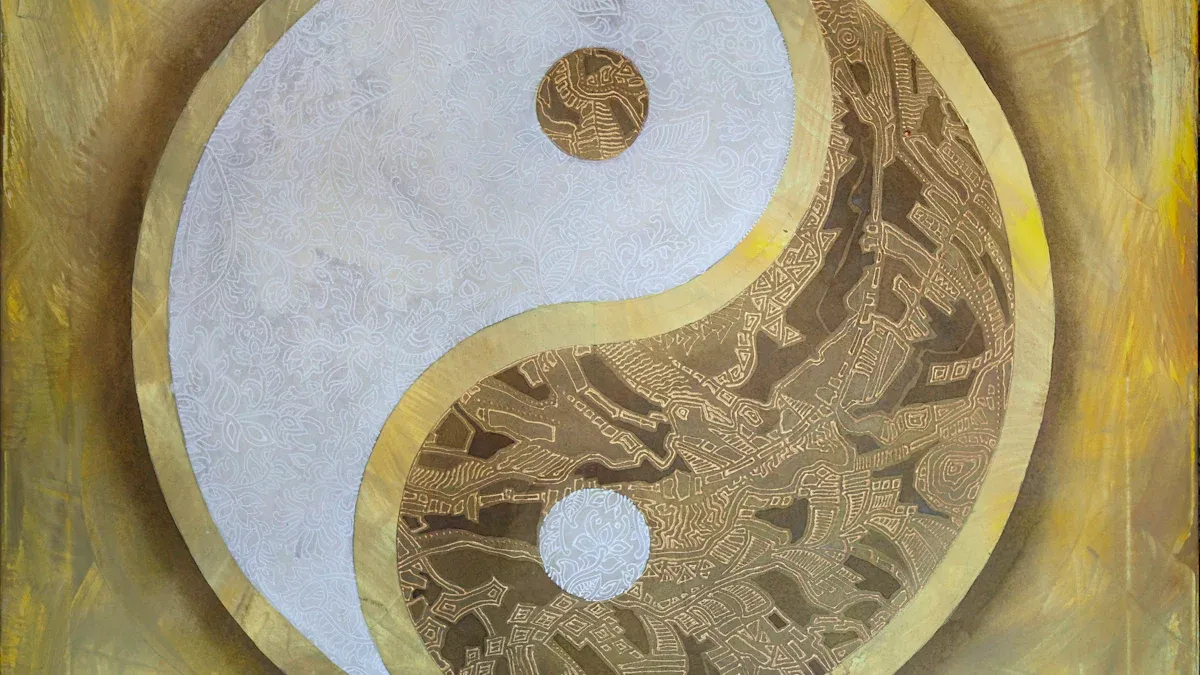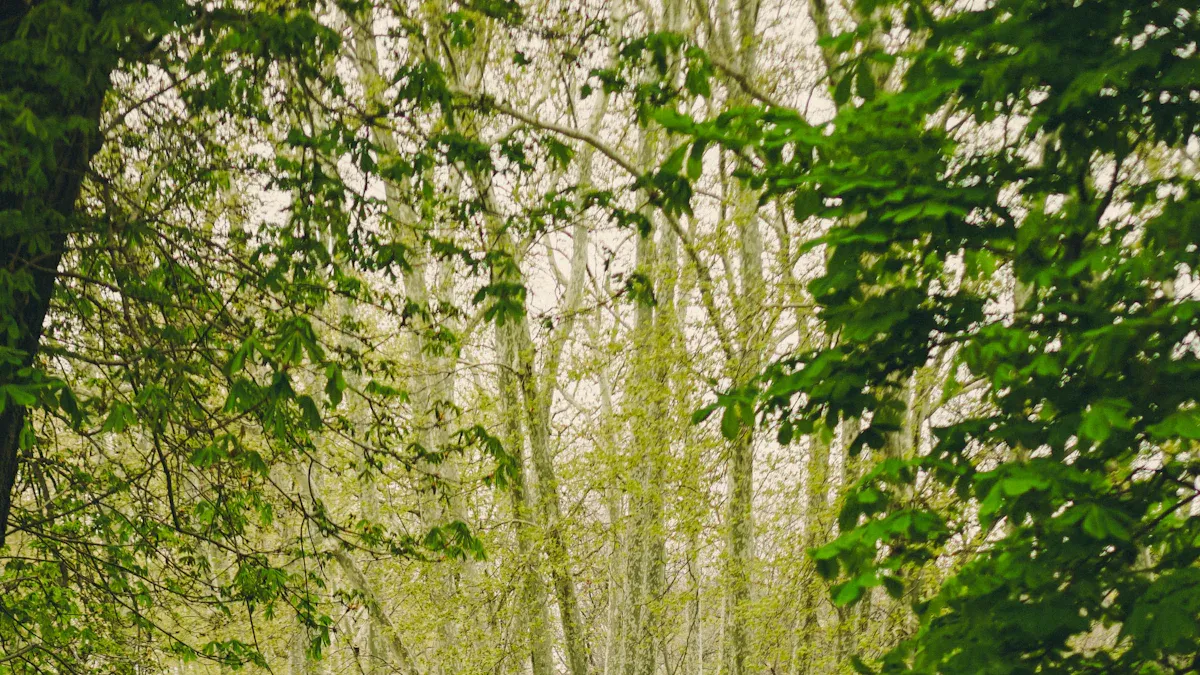
Have you ever wondered if you could find peace and wonder in the middle of your busy city life? You can use taoism to turn a simple walk through urban green spaces into a journey of discovery. The Tao Te Ching teaches you to see nature with fresh eyes and to notice the small details. When you practice mindfulness outdoors, you build a strong connection with both nature and yourself. Many people find that even in an urban setting, tao and taoism help create balance and connection. With each step, you deepen your connection to the Tao Te Ching and the world around you.
Key Takeaways
Use Taoist mindfulness to make city walks calm and special. Notice small things in nature as you walk.
Pick green spaces close to you, like parks or gardens. This helps you connect with nature often and easily.
Try mindful walking and breathing to relax your mind. These exercises help you feel closer to nature.
Accept city distractions by paying attention to natural sounds. Go with the flow of what is around you.
Bring Taoist harmony into your life with simple meditation. You can also journal or do kind things for others. This helps you feel balanced and connected.
Taoism Mindset

Taoist Concepts
When you step into a natural setting, you can bring the wisdom of the Tao Te Ching with you. Taoism teaches you to see the tao in everything around you. The tao is the source of all things and connects you to the world. You can find harmony by practicing taoist meditation and noticing the interconnectedness of all things. The Tao Te Ching reminds you that contentment, oneness, and living in tune with nature help you feel at peace. Taoism values Wu Wei, or effortless action. This means you act when needed but do not force things. In a city park, you can practice mindfulness and let your actions flow with the tao. You notice how the tao expresses itself in the trees, the wind, and even the people passing by. Taoist meditation helps you sense the interconnectedness between yourself and your surroundings. When you align with the tao, you feel a sense of harmony and balance.
Simplicity and Naturalness
Taoism encourages you to live simply and naturally. The tTao Te Ching says that less is often more. In a natural setting, you can let go of distractions and focus on what is truly important. Mindfulness helps you notice small details, like the sound of leaves or the feeling of sunlight. Taoist meditation guides you to slow down and enjoy the present moment. You do not need to chase after more; you can find joy in what is already there. When you practice simplicity, you create space for harmony and interconnectedness. The tao teaches you to respect natural limits and avoid unnecessary desires. This way, you move closer to the tao and experience true contentment.
Beginner’s Mind
Approaching your journey with a beginner’s mind means you stay open and curious. The Tao Te Ching invites you to see each moment as new. Taoist meditation helps you let go of old habits and expectations. You notice the tao in every part of your walk, from the smallest flower to the largest tree. Mindfulness keeps you present, and you discover the interconnectedness of all things. When you align with the tao, you accept change and adapt with ease. Harmony grows when you meet each experience with fresh eyes. In this way, taoism turns an ordinary walk into a journey of discovery and connection.
Preparing Your Nature Micro Trip
Choosing Green Spaces
You can start your journey by exploring the many types of urban green spaces around you. Cities offer parks, forests, street trees, pocket parks, and even green roofs. These places bring nature closer to your daily life. When you look for a spot, choose one that feels inviting and easy to reach. Experts suggest finding a green space within a short walk, like 300 meters, so you can visit often. A forest area or a park with lots of trees can give you a peaceful natural setting. Trees help cool the air and make the space feel fresh. If you enjoy urban gardening, you might visit a community garden or a small green area. These places let you connect with nature and see how plants grow in the city.
Setting Intentions
Before you step into a natural setting, take a moment to set your intentions. You can focus your mind by paying attention to the light, the sound of water, or the feeling of the breeze. Try to notice the details of the forest, like the texture of bark or the movement of leaves. Mindful intentions help you stay present and enjoy every part of nature. You might want to bring a journal to write down your thoughts or draw what you see. This practice helps you build a deeper connection with the forest and the natural world. When you set clear intentions, you make your time in nature more meaningful.
Living Sustainably
As you explore, remember to care for the environment. Choose to walk or bike to your green space to lower your impact. This supports a sustainable lifestyle and helps keep the air clean. When you visit a forest or park, respect the plants and animals. Pick up any trash you see and leave the space better than you found it. Living sustainably means making choices that protect nature for everyone. Urban gardening also supports a sustainable city by growing food and flowers close to home. Every small action, like using less plastic or joining a local clean-up, helps create a healthy, natural setting for all.
Mindfulness Practices in Nature

Exploring nature with a Taoist mindset means you bring mindfulness into every step. You can use simple practices to deepen your connection with the forest and the world around you. These exercises help you tune into your senses, ground yourself, and discover the extraordinary in the ordinary.
Mindful Walking
Mindful walking in nature is a powerful way to connect with the forest and yourself. You do not need to rush. Instead, you move slowly and notice each step. This practice helps you ground yourself and feel the earth beneath your feet. When you walk mindfully, you let your senses guide you. You listen to the sounds of birds, feel the breeze, and smell the fresh air. You can even notice the texture of the path or the way sunlight filters through the trees.
Tip: Try to walk in silence for a few minutes. Let your senses lead the way.
Many studies show that mindful walking in green spaces reduces anxiety, stress, and negative thoughts. People often feel happier and more relaxed after walking in nature. The forest helps restore your attention and gives your mind a break from busy city life. Mindful walking also supports your immune system and heart health. Forest bathing, a form of mindful walking, brings deep relaxation and peace.
You can follow these steps for mindful walking:
Stand still for a moment. Take a deep breath and notice your surroundings.
Begin to walk slowly. Focus on each step and how your feet touch the ground.
Tune into your senses. Listen, look, smell, and feel the world around you.
If your mind wanders, gently bring your attention back to your steps and breath.
Pause now and then to enjoy the forest and the feeling of interconnectedness.
When you practice mindful walking, you build a mindful relationship with nature. You notice the small wonders in the forest and feel a sense of connection with all living things.
Breathing Exercises
Breathing exercises help you ground yourself and bring calm to your mind. In the forest, you can use your breath to tune into your senses and deepen your connection with nature. Taoist meditation often starts with simple breathing. You can try this easy exercise:
Find a quiet spot in the forest or park.
Stand or sit comfortably. Close your eyes if you like.
Take a slow, deep breath in through your nose. Feel your chest and belly rise.
Exhale gently through your mouth. Let your body relax.
Repeat this for a few minutes. Focus on the feeling of air moving in and out.
Note: If you feel distracted, bring your attention back to your breath. Let the sounds of nature guide you.
Breathing with awareness helps you ground yourself and connect with the present moment. You may notice the scent of pine, the coolness of the air, or the gentle rustle of leaves. This sensory connection brings you closer to the forest and supports your meditation practice. Regular breathing exercises improve your mood, reduce stress, and help you feel more balanced.
Observation and Nature Connection
Observation is a key part of mindfulness and Taoist meditation. When you observe nature with care, you discover the magic in everyday moments. You can use your senses to explore the forest and build a deeper connection with the world around you.
Here are some expert-recommended ways to enhance your observation and nature connection:
Walk slowly and pay attention to each step, sound, and breath. This mindful movement helps you immerse yourself in the forest.
Try birdwatching. Notice the colors, shapes, and behaviors of birds. This practice brings joy and sharpens your senses.
Keep a nature journal. Sketch or write about what you see, hear, and feel. Journaling helps you remember your experiences and see patterns in nature.
Lie down and watch the clouds. Let your imagination wander as you see shapes and stories in the sky.
Stack stones or build small cairns. This activity teaches patience and balance.
Take photos of the forest. Focus on details like leaves, bark, or sunlight. Photography helps you see nature from new angles.
Practice nature meditation. Sit quietly and tune into your senses. Listen to the wind, smell the earth, and feel the air on your skin.
Callout: Even short moments of observation can deepen your nature connection and reduce stress. Spending at least two hours a week in nature improves mental health.
When you engage your senses and tune into your senses, you notice the interconnectedness of all living things. You see how the forest, the air, and the animals all work together. This awareness grows your sense of connection and helps you build a mindful relationship with nature. Taoist meditation encourages you to observe without judgment and accept each moment as it is.
By practicing mindful walking, breathing exercises, and observation, you discover the extraordinary in the ordinary. You learn to ground yourself, engage your senses, and celebrate the interconnectedness of the forest and your own life. Each visit to nature becomes a journey of meditation, connection, and wonder.
Overcoming Urban Challenges
Acceptance and Adaptability
You may notice that city green spaces often feel busy and unpredictable. Noise, crowds, and even social tensions can make it hard to find peace. The Tao Te Ching teaches you to accept what you cannot change and adapt with grace. When you walk through a park and hear city sounds, you can practice living in harmony with your surroundings. The tao reminds you that harmony comes from flowing with what is present, not fighting against it. Wu Wei, or effortless action, helps you respond to changes without stress. You let things unfold naturally, just as the Tao Te Ching suggests. This approach allows you to enjoy the moment, even when the urban environment feels chaotic.
Handling Distractions
Distractions are common in urban green spaces. You might hear car horns, loud voices, or construction. The Tao Te Ching encourages you to shift your focus gently. You can listen for natural sounds, like birds or the wind, and let them guide your attention. Some people use simple tricks, such as plugging their ears or playing soft music, to create a sense of harmony. The tao teaches you to accept both pleasant and unpleasant sounds as part of the whole. By practicing living in harmony, you learn to blend with your environment. This helps you stay calm and connected to the tao, even in a noisy city.
Finding Calm
Finding calm in an urban park takes practice. The Tao Te Ching offers guidance for building inner peace. You can pause, take a deep breath, and notice the tao in every detail—the rustle of leaves, the warmth of sunlight, or the pattern of clouds. When you focus on these small wonders, you create harmony within yourself. The tao reminds you that peace does not depend on silence or emptiness. Instead, you find it by living in harmony with the world as it is. Each visit to a green space becomes a chance to practice the wisdom of the Tao Te Ching and discover new ways to connect with harmony.
Integrating Taoism and Nature Connection Daily
Everyday Mindfulness
You can bring the feeling of the forest into your daily life. Try Taoist meditation each morning with mindful breathing. Focus on your lower belly and let your breath move naturally. This easy meditation gives you energy and helps you feel calm. Spend a few minutes outside, even if you just look at the sky or listen to birds. Let your senses show you what is around. Notice the colors, sounds, and smells of nature. When you walk to school or work, turn your steps into a mindful walk. Feel the ground under your feet and sense how you connect with the world. Try not to control everything and trust the natural flow of your day. Living in harmony with nature means accepting changes like weather or noise. Use these changes to feel even more connected. Even short moments with nature can remind you of the forest and help you find balance.
Tip: Take a mindful break during the day. Go outside, close your eyes, and listen to nature. Let your senses refresh your mind.
Reflective Journaling
Journaling is a great way to keep your nature connection strong. After you spend time in the forest, write about what you saw, heard, and felt. Describe how your senses reacted and how meditation changed your mood. Think about moments when you felt harmony or interconnectedness. This practice helps you notice your thoughts and feelings. Studies show that journaling supports mindfulness and helps you stay present. It also helps you see patterns in your connection with nature and the forest. Over time, you will see your meditation and nature connection get stronger. Journaling can also help you feel thankful and live more sustainably.
Acts of Kindness
Small acts of kindness help you share harmony and interconnectedness with others. Taoist meditation teaches you to act gently and support others without forcing change. You can help a friend feel accepted, pick up litter in a park, or listen to someone who needs support. Living simply gives you more time to care for your community and the environment. Invite others to join you in nature connection or meditation. When you show kindness, you help build a caring, sustainable community. These actions show Taoist values of harmony, simplicity, and interconnectedness. Over time, your kindness will help your city feel more like a forest—peaceful, balanced, and full of connection.
You can make a walk in the park feel special with taoist meditation and the Tao Te Ching. When you meditate and think about the tao, you feel calm and close to nature. Many people feel happy and peaceful after meditating in green spaces. The Tao Te Ching and meditation help you notice the magic in trees and every moment. Try to use meditation, the tao, and the forest’s wisdom every day. Share what you learn and help others find their own connection with nature and the tao.
FAQ
What is the best way to start a Taoist nature walk in the city?
You can begin by taking a deep breath and noticing your surroundings. Focus on your steps and let your senses guide you. Stay curious and open to new sights and sounds.
How can I stay mindful if the park is noisy?
Try to listen for natural sounds, like birds or wind. Let these sounds become your focus. If you get distracted, gently bring your attention back to your breath or the feeling of your feet on the ground.
Do I need special tools or clothes for a Taoist micro trip?
No special tools are needed. Wear comfortable clothes and shoes. Bring a small notebook if you want to write or draw. The most important thing is your open mind.
Can I practice Taoist mindfulness in small green spaces?
Absolutely! Even a tiny garden or a single tree can help you connect with nature. Use your senses to explore what is around you. Every green space offers something special.






